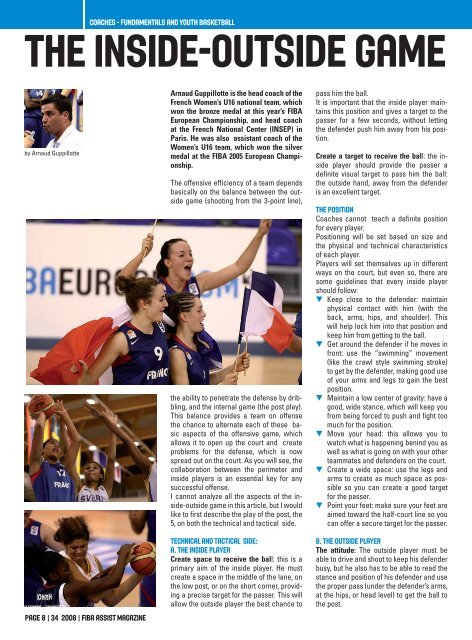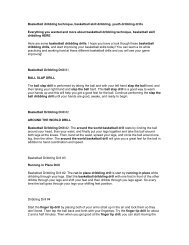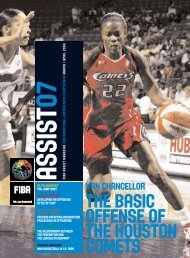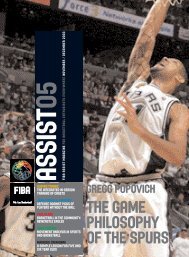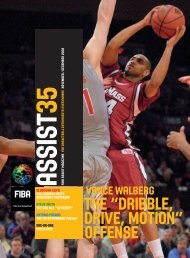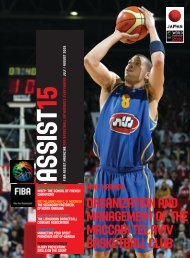“SLICE” AND “POINT” SETS - FIBA.com
“SLICE” AND “POINT” SETS - FIBA.com
“SLICE” AND “POINT” SETS - FIBA.com
You also want an ePaper? Increase the reach of your titles
YUMPU automatically turns print PDFs into web optimized ePapers that Google loves.
COACHES - FUNDAMENTALS <strong>AND</strong> YOUTH BASKETBALL<br />
The Inside-Outside Game<br />
by Arnaud Guppillotte<br />
page 8 | 34 2008 | Fiba Assist Magazine<br />
Arnaud Guppillotte is the head coach of the<br />
French Women’s U16 national team, which<br />
won the bronze medal at this year’s <strong>FIBA</strong><br />
European Championship, and head coach<br />
at the French National Center (INSEP) in<br />
Paris. He was also assistant coach of the<br />
Women’s U16 team, which won the silver<br />
medal at the <strong>FIBA</strong> 2005 European Championship.<br />
The offensive efficiency of a team depends<br />
basically on the balance between the outside<br />
game (shooting from the 3-point line),<br />
the ability to penetrate the defense by dribbling,<br />
and the internal game (the post play).<br />
This balance provides a team on offense<br />
the chance to alternate each of these basic<br />
aspects of the offensive game, which<br />
allows it to open up the court and create<br />
problems for the defense, which is now<br />
spread out on the court. As you will see, the<br />
collaboration between the perimeter and<br />
inside players is an essential key for any<br />
successful offense.<br />
I cannot analyze all the aspects of the inside-outside<br />
game in this article, but I would<br />
like to first describe the play of the post, the<br />
5, on both the technical and tactical side.<br />
TECHNICAL <strong>AND</strong> TACTICAL SIDE:<br />
A. THE INSIDE PLAYER<br />
Create space to receive the ball: this is a<br />
primary aim of the inside player. He must<br />
create a space in the middle of the lane, on<br />
the low post, or on the short corner, providing<br />
a precise target for the passer. This will<br />
allow the outside player the best chance to<br />
pass him the ball.<br />
It is important that the inside player maintains<br />
this position and gives a target to the<br />
passer for a few seconds, without letting<br />
the defender push him away from his position.<br />
Create a target to receive the ball: the inside<br />
player should provide the passer a<br />
definite visual target to pass him the ball:<br />
the outside hand, away from the defender<br />
is an excellent target.<br />
THE POSITION<br />
Coaches cannot teach a definite position<br />
for every player.<br />
Positioning will be set based on size and<br />
the physical and technical characteristics<br />
of each player.<br />
Players will set themselves up in different<br />
ways on the court, but even so, there are<br />
some guidelines that every inside player<br />
should follow:<br />
▼ Keep close to the defender: maintain<br />
physical contact with him (with the<br />
back, arms, hips, and shoulder). This<br />
will help lock him into that position and<br />
keep him from getting to the ball.<br />
▼ Get around the defender if he moves in<br />
front: use the “swimming” movement<br />
(like the crawl style swimming stroke)<br />
to get by the defender, making good use<br />
of your arms and legs to gain the best<br />
position.<br />
▼ Maintain a low center of gravity: have a<br />
good, wide stance, which will keep you<br />
from being forced to push and fight too<br />
much for the position.<br />
▼ Move your head: this allows you to<br />
watch what is happening benind you as<br />
well as what is going on with your other<br />
teammates and defenders on the court.<br />
▼ Create a wide space: use the legs and<br />
arms to create as much space as possible<br />
so you can create a good target<br />
for the passer.<br />
▼ Point your feet: make sure your feet are<br />
aimed toward the half-court line so you<br />
can offer a secure target for the passer.<br />
B. THE OUTSIDE PLAYER<br />
The attitude: The outside player must be<br />
able to drive and shoot to keep his defender<br />
busy, but he also has to be able to read the<br />
stance and position of his defender and use<br />
the proper pass (under the defender’s arms,<br />
at the hips, or head level) to get the ball to<br />
the post.


